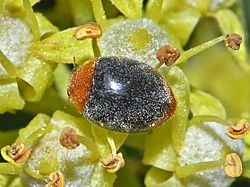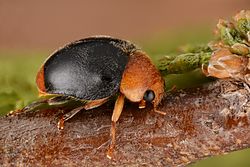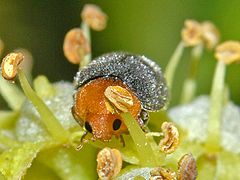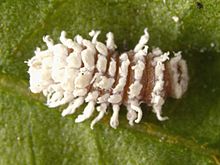Cryptolaemus montrouzieri facts for kids
Quick facts for kids Cryptolaemus montrouzieri |
|
|---|---|
 |
|
| Cryptolaemus montrouzieri. Dorsal view | |
 |
|
| Side view | |
| Scientific classification | |
| Kingdom: | |
| Phylum: | |
| Class: | |
| Order: | |
| Family: | |
| Genus: |
Cryptolaemus
|
| Species: |
C. montrouzieri
|
| Binomial name | |
| Cryptolaemus montrouzieri Mulsant, 1850
|
|
Cryptolaemus montrouzieri, common name mealybug ladybird or mealybug destroyer, is a ladybird species.
Etymology
Étienne Mulsant described C. montrouzieri, naming the new species after a Marist brother and missionary, Abbe Montrouzier, who wrote an "Insect Fauna of Woodlark Island".
Distribution
Cryptolaemus montrouzieri is endemic to Queensland and New South Wales, Australia. It is now also present in southern Europe (France, Italy, Spain, Greece), in North Africa, in the Afrotropical realm, in the Nearctic realm, and in the Neotropical realm.
Description
Cryptolaemus montrouzieri can reach a length of about 6 millimetres (0.24 in). Adults of this species have the typical ladybird shape but, unlike many of the often brightly coloured Coccinellidae, the elytra of these small ladybirds are predominantly dark brown and have no spots. Head, antennae, pronotum, the end of the elytra and the legs are orange-brown. Larvae can reach a length of 14–15 millimetres (0.55–0.59 in). They show a waxy covering that makes them apparently look like the mealybugs they prey on, a case of aggressive mimicry.
Biology
The adults and larvae of these insects eat scale insects, especially mealybugs. Females lay their eggs among the egg sack of mealybugs. Larvae feed on mealybug eggs, young crawlers and their honeydew. They become adults in 24 days, after three larval stages and a pupal stage. The life span lasts two months.
Biological control agent
This species has been used as a biological control agent against mealybugs and other scale insects. It was introduced to Western Australia. In California it was introduced in 1891 by Albert Koebele to control the citrus mealybug. It has also been introduced to New Zealand for biocontrol. As biological control agent outside Australia, C. montrouzieri has the common name Mealy bug destroyer.
See also
 In Spanish: Cryptolaemus montrouzieri para niños
In Spanish: Cryptolaemus montrouzieri para niños



